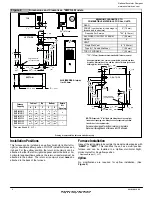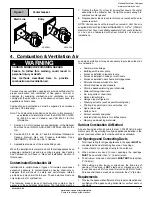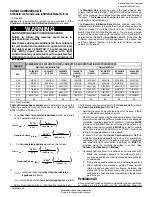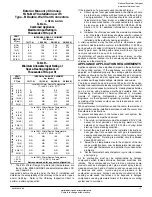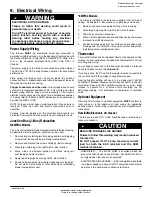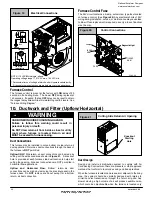
441 01 2613 05
11
Specifications are subject to change without notice
Indoor Combustion Air
Standard
and
Known-Air-Infiltration Rate
Methods
NFPA & AGA
Indoor
air
is permitted for combustion and ventilation, if the
Standard
or
Known
!
Air
!
Infiltration Rate
Method is used.
!
CARBON MONOXIDE POISONING HAZARD
Failure to follow this warning could result in
personal injury or death.
Most homes will require additional air from outdoors
for combustion and ventilation. A space with at least
50 cubic feet per 1,000 BTUH (1.4 cubic meters per
.293 kW/h) input rating or homes with tight
construction may need outdoor air to supplement air
infiltration for proper combustion and ventilation of
flue gases.
WARNING
The
Standard
Method may be used, if the space has no less
volume than 50 cubic feet per 1,000 BTUH (4.8 cubic meters per
kW) of the maximum input ratings for all gas appliances installed in
the space. The
standard
method permits indoor air to be used for
combustion and ventilation air.
The
Known Air Infiltration Rate
Method shall be used if the
infiltration rate is known to be less than 0.40 air changes per hour
(ACH) and equal to or greater than 0.10 ACH. Infiltration rates
greater than 0.60 ACH shall not be used. The minimum required
volume of the space varies with the number of ACH and shall be
determined per
Table 2
or
Equations 1 and 2
. Determine the
minimum required volume for each appliance in the space, and
add the volumes together to get the total minimum required
volume for the space.
Table 2
M
INIMUM SPACE VOLUME FOR 100% COMBUSTION AND VENTILATION AIR FROM INDOORS
Other Than Fan-Assisted Total
Fan-assisted Total
ACH
30,000 BTU
(8.79 kW)
40,000 BTU
(11.72 kW)
50,000 BTU
(14.65 kW)
50,000 BTU
(14.65 kW)
75,000
(21.98 kW)
100,000 BTU
(29.30 kW)
125,000 BTU
(36.63 kW)
150,000 BTU
(43.95 kW)
ft
3
(
m
3
)
0.60
1,050 (29.7)
1,400 (39.2)
1,750 (49)
1,250 (35)
1,875 (52.5)
2,500 (70)
3,125 (87.5)
3,750 (105)
0.50
1,260 (35.3)
1,680 (47.04)
2,100 (58.8)
1,500 (42)
2,250 (63)
3,000 (84)
3,750 (105)
4,500 (126)
0.40
1,575 (44.1)
2,100 (58.8)
2,625 (73.5)
1,875 (52.5)
2,813 (78.8)
3,750 (105)
4,688 (131.3)
5,625 (158)
0.30
2,100 (58.8)
2,800 (78.4)
3,500 (98)
2,500 (70)
3,750 (105)
5,000 (140)
6,250 (175)
7,500 (210.6)
0.20
3,150 (88.2)
4,200 (117.6)
5,250 (147)
3,750 (105)
5,625 (157.5)
7,500 (210)
9,375 (262.5)
11,250 (316)
0.10
6,300 (176.4)
8,400 (235.2)
10,500 (294)
7,500 (210)
11,250 (315)
15,000 (420)
18,750 (525)
22,500 (632)
0.00
NP
NP
NP
NP
NP
NP
NP
NP
NP = Not Permitted
Table 2
Minimum Space Volumes
were determined by using the
following equations from the National Fuel Gas Code ANSI
Z223.1/NFPA 54
!
2009, 9.3.2.2:
1. For
other than fan
!
assisted appliances
such as a draft
hood
!
equipped water heater,
1000 Btu / hr
21 ft
3
(
I
other
)
Volume other
=
ACH
.293 kW / hr
59 m
3
(
I
other
)
Required Volume other
!
ACH
2.
For
fan
!
assisted appliances
such as this furnace,
1000 Btu / hr
15 ft
3
(
I
fan
)
Volume fan
=
ACH
.293 kW / hr
.42 m
3
(
I
fan
)
Required Volume fan
!
ACH
If:
I
other
= combined input of all
other than fan
!
assisted
appliances
in Btu/hr
I
fan
= combined input of all
fan
!
assisted appliances
in Btu/hr
ACH = air changes per hour (ACH shall not exceed 0.60.)
The following requirements apply to the
Standar
d Method and to
the
Known Air Infiltration
Rate Method.
•
Adjoining rooms can be considered part of a space, if there
are no closable doors between rooms.
•
An attic or crawl space may be considered a space that freely
communicates with the outdoors provided there are adequate
ventilation openings directly to outdoors. Openings
MUST
remain open and
NOT
have any means of being closed off.
Ventilation openings to outdoors
MUST
be at least 1 square
inch of free area per 4,000 BTUH (5.5 cm
2
/kW) of total input
rating for all gas appliances in the space.
•
In spaces that use the
Indoor Combustion Air
Method,
infiltration should be adequate to provide air for combustion,
ventilation and dilution of flue gases. However, in buildings
with unusually tight construction, additional air
MUST
be
provided using the methods described in section titled
Outdoor Combustion Air
Method
:
•
Unusually tight construction is defined as Construction with:
1. Walls and ceilings exposed to the outdoors have a
continuous, sealed vapor barrier. Openings are gasketed
or sealed and
2. Doors and openable windows are weather stripped and
3. Other openings are caulked or sealed. These include
joints around window and door frames, between sole
plates and floors, between wall
!
ceiling joints, between
wall panels, at penetrations for plumbing, electrical and
gas lines, etc.
Ventilation Air
Some provincial codes and local municipalities require ventilation
or make
!
up air be brought into the conditioned space as
National Excelsior Company
www.excelsiorhvac.com
Subject to change without notice.






